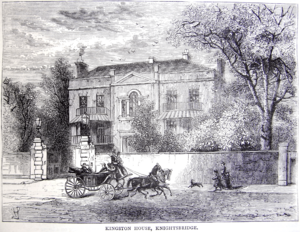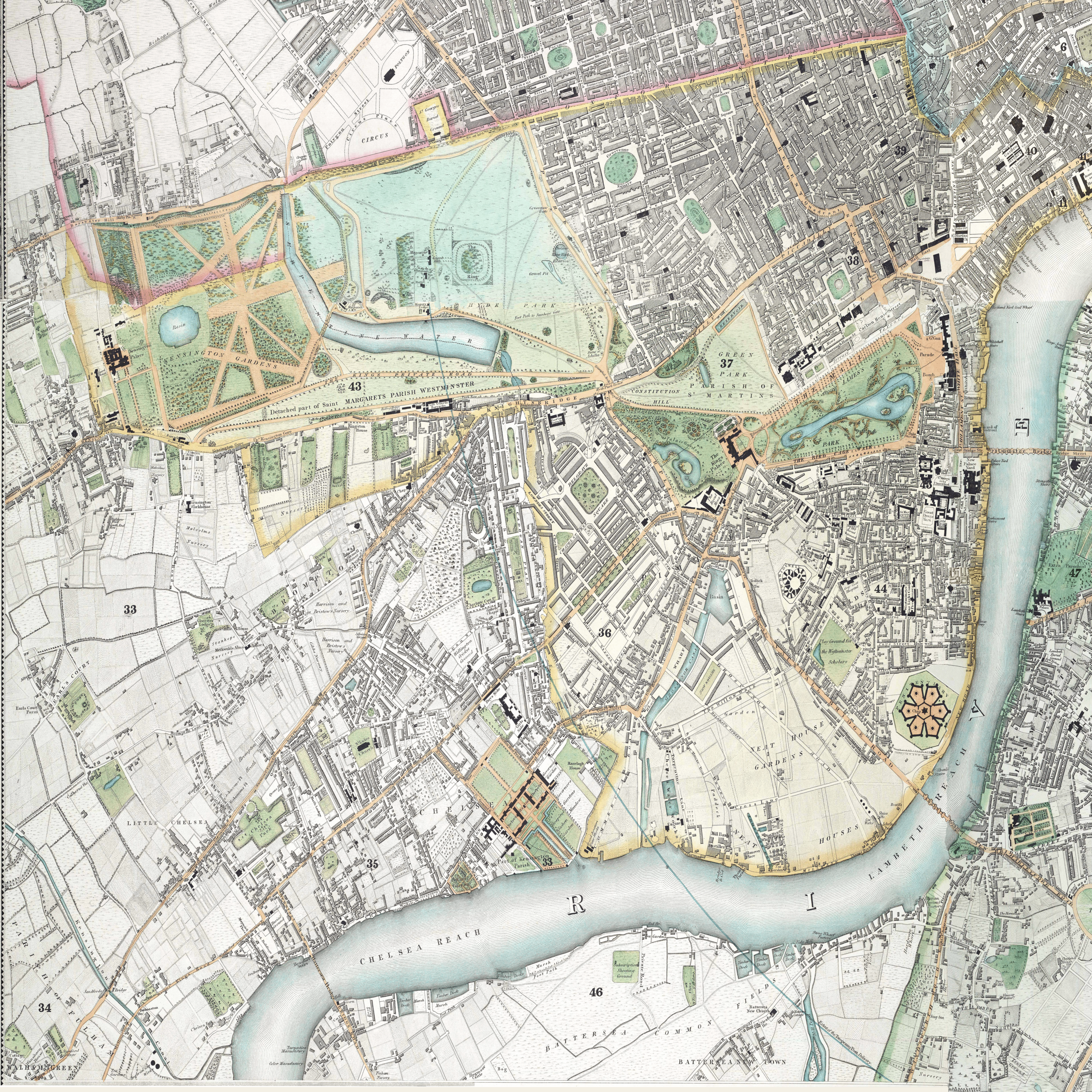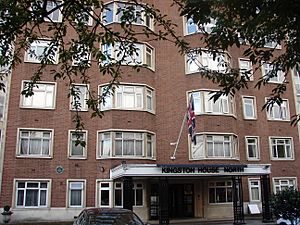Kingston House estate, London facts for kids
The Kingston House estate and Ennismore Gardens are two special areas in Knightsbridge, a part of London. They are known for their green spaces and unique buildings. The Kingston House estate is just south of Hyde Park, London, and includes buildings like Kingston House North and South. Ennismore Gardens is a beautiful garden square with 59 tall, creamy-white houses. It's also home to the Russian Orthodox Cathedral of the Dormition of the Mother of God and All Saints. Many of the buildings in this area are considered 'listed buildings', which means they are protected because of their history and special architecture.
Contents
Kingston House Estate: A Look Back
The Kingston House estate has some cool Art Deco designs, but its buildings aren't officially listed as historic. It has four blocks of flats built between the 1930s and 1950s, all in the 1930s style.
The Original Kingston House
The first Kingston House was a grand mansion, originally called Chudleigh House. It was built in the mid-1700s for Elizabeth Pierrepont, Duchess of Kingston-upon-Hull, by Evelyn Pierrepont, 2nd Duke of Kingston-upon-Hull.
After Elizabeth died, the house was owned by different people. One famous person who lived there was Richard Wellesley, 1st Marquess Wellesley, who died in the house in 1842. Another famous resident was Baron Lionel de Rothschild, a very important banker.
In 1935, the house was sold. It was knocked down in 1937 to make way for new buildings. In its place, two large apartment blocks were built: Kingston House North and Kingston House South.
Early Changes and New Buildings
In the 1840s, new houses started to appear in the area. The Ennismore Arms pub was one of the first buildings, built in 1845-47. It was damaged during World War II and rebuilt, but later closed and was demolished.
All Saints' Church
All Saints' Church was built in 1848–49. It was designed in the Italianate style. The church has beautiful murals inside. In 1956, it became the Russian Orthodox Patriarchial Church of The Assumption of All Saints. Its amazing organ was moved to another church.
Ennismore Gardens Takes Shape
In the 1860s and 1870s, more land was developed. This is when the rest of Ennismore Gardens was created, including the private garden in the middle. The houses here are five storeys tall and have fancy columns. All 55 of these houses are listed buildings, meaning they are protected for their historical importance. Many of the street lamps are also listed!
Other Grand Houses
Moncorvo House was finished in 1880. It was named after the Portuguese ambassador in London. Bolney House was built in 1883 by a famous architect, Richard Norman Shaw. Both of these grand houses were later demolished.
Kingston House Today
From the 1930s onwards, many of the original buildings, including Kingston House itself, were replaced by modern apartment blocks and townhouses. During World War II, the Norwegian government-in-exile used Kingston House North as an important base.
After the war, more new buildings were constructed. Kingston House East and the two blocks of Kingston House South were built on the land where the old Kingston House once stood.
Ennismore Gardens: Famous Faces and Places
The Hampshire School, a private school, was located at number 63 from 1933 to 2008.
The famous Hollywood actress Ava Gardner lived at number 34 from 1968 until she passed away in 1990. There's a special blue plaque on the wall of her home to remember her. You can also see an ornamental urn in the garden square in her honour. People often saw her going for a swim at a nearby pool!
The Libyan consulate and visa office are at numbers 61–62. This is where people go to get visas to visit Libya.
Ennismore Garden Mews: Film Locations
Ennismore Garden Mews is a small street that has been used in movies!
- Alfred Hitchcock used number 31 as a home in his 1972 film Frenzy.
- A 1987 TV advert for the VW Golf car, directed by David Bailey, showed Paula Hamilton leaving number 23.
Notable Residents
Many interesting people have lived in the Kingston House estate and Ennismore Gardens over the years.
Kingston House North
- General Nick Houghton: A very important military leader, the Chief of the Defence Staff for the British Armed Forces.
- Johan Nygaardsvold: The Prime Minister of Norway during World War II, when his government was in exile.
- Kenneth More: A well-known actor.
- Nazim Azman: A racing driver.
Kingston House South
- Hugh Trenchard, 1st Viscount Trenchard: A key figure in the early days of the Royal Air Force.
- Margaret Pyke: A pioneer in family planning.
Moncorvo House (now demolished)
- Albert George Sandeman: He was the Governor of the Bank of England.
- Henri d'Orleans, duke of Aumale: A French prince.
Bolney House (now demolished)
- Henry Tate junior: The son of Henry Tate, who founded the Tate art galleries.
- Sydney Martineau: An Olympic fencer.
Ennismore Gardens
The first people to live here were often aristocrats and politicians. Later, artists and actors also moved in.
- Lord St John of Fawsley: A British politician.
- William Brett, 1st Viscount Esher: A famous judge.
- Sir John Brunner, 1st Baronet: An important industrialist and Member of Parliament (MP).
- Walter Long, 1st Viscount Long: A British statesman.
- Victor Bruce, 9th Earl of Elgin: A Scottish nobleman.
- Sir Granville Ryrie: The High Commissioner for Australia.
- Frederick DuCane Godman: A zoologist who studied animals.
- Herbert Plumer, 1st Viscount Plumer: A British Army field marshal.
- Arthur Hood, 1st Baron Hood of Avalon: A British admiral.
- Sir Pyotr Bark: A Russian statesman.
- Charles Gray: An actor.
- Henry Yates Thompson: A newspaper owner and collector of old books.
- Ava Gardner: The famous Hollywood actress.
- Jack Hawkins: An actor.
- Gavin Campbell, 1st Marquess of Breadalbane: A Scottish nobleman.
- Moura Budberg: A literary hostess.
- Edith Summerskill, Baroness Summerskill: A politician and writer.
Ennismore Gardens Mews
- Sir Michael Caine: A very famous actor.
- Terence Stamp: An actor.
- Sir Alec Guinness: Another very famous actor, known for Star Wars.




